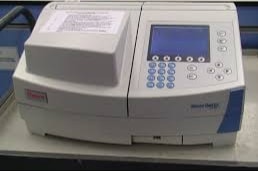UV-visible spectrophotometer are widely used in the pharmaceutical industry for analyzing and quantifying various drug substances. It is important to ensure that these instruments are calibrated accurately and regularly to obtain reliable and accurate results. In this guide, we will take you through the calibration procedure and parameters of a UV spectrophotometer.

Calibration of UV-visible spectrophotometer by parts
Calibration of the UV Spectrophotometer includes the following:
- Absorption cells
- Control of absorbance
- For UV region
- For visible region
- Photo metric linearity
- Limit of stray light
- Resolution power
- Control of Wavelengths
1. Absorption cells
- Fill the cuvette with milli-Q water at 240 nm, and absorption is not greater than 0.093 of the individual cuvette.
- Rotate both cuvettes (180°) one by one.
Acceptance criteria: When you Rotate the cuvette, it should show a change in absorbance of no more than 0.005.
2. Control of Absorbance:
2a. For UV region
Solution A: Prepared 0.005M sulfuric acid:
Weigh accurately 60.0 mg of potassium dichromate, Make sure it’s completely dry by heating it at 130°C. Then, dissolve it in 1000 ml of 0.005 M sulfuric acid.
Measure the absorbance at 235nm, 257nm, 313nm, and 350nm using 0.005M H2SO4 as blank.
2b. For Visible Region
Solution B: Weight about 60.0 mg of potassium dichromate, which previously dried to constant weight at 130°C. After that, put it into a 100 ml measuring flask and dissolve it in 0.005 M sulfuric acid.
Measure the absorbance at 430nm using 0.005M sulphuric acid as blank.
Acceptance criteria:
| Soln. type/ wavelengths (nm) | Specific abs. | Max.Tolerance |
| Solution A: 235 | 124.5 | 122.9 to 126.2 |
| Solution A: 257 | 144.5 | 142.8 to 145.7 |
| Solution A: 313 | 48.6 | 47.0 to 50.3 |
| Solution A: 350 | 107.3 | 104.9 to 108.2 |
| Solution B: 430 | 15.9 | 15.7 to 16.1 |
3. Photometric Linearity
Weight 50 mg Potassium dichromate and dissolved in 0.005 M Sulphuric acid in a 50 ml volumetric flask. Further, dilute the above solution in the following way:
1 ml ≥ 100 ml
2 ml ≥ 100 ml
3 ml ≥ 100 ml
4 ml ≥ 100 ml
5 ml ≥ 100 ml
Take consecutive three readings of each dilution at 235, 257, 313, and 350 nm wavelength.
Acceptance criteria:
At each wavelength mean value ≥ 0.999
4. Limit of Stray light
Prepare 1.2 % v/v solution by using Potassium chloride in 50 ml Distilled water and make up the volume up to 100 ml by using distilled water. Run the solution at 200 nm using water as a blank.
Acceptance criteria: Absorbance at 200 nm should be greater than 2.0
5. Resolution power
Prepared 0.02% v/v solution by using Toluene in hexane and scanned at 250 nm to 300 nm using hexane as a reference.
Record the absorption at 269 nm and 266 nm.
Calculate the absorption ratio by dividing the absorbance at 269 nm (Maxima) and 266 nm (minima).
Acceptance criteria: The absorbance maxima at 269 nm to the minima at 266 nm should not be less than 1.5.
6. Control of Wavelengths
By using the Holmium perchlorate method:
This test is crucial to make sure that the instrument wavelength and the detector are working correctly. We can do this by using the Holmium perchlorate method.
Take and dissolve 1.0 grams of holmium oxide with 1.4 M perchloric acid and heat it on a water bath. After that, let it cool, and then add more of the same liquid to make a 4.0% weight/volume solution of holmium oxide with a total volume of 25 milliliters.
Next, Record the spectrum of the holmium perchlorate solution from 200 nm to 600 nm, using 1.4 M perchloric acid as a reference solution.
Acceptance Criteria:
| Maxima Wavelength (nm) | Maxi. Tolerance (nm) |
|---|---|
| 241.15 | 240.15 to 242.15 |
| 287.15 | 286.15 to 288.15 |
| 361.50 | 360.50 to 362.50 |
| 536.30 | 533.30 to 539.30 |
By using Discharge Lamp Methods:
Take 100 mg of potassium dichromate in 20 ml of 0.05 N KOH. After that, add more of the same solution to make it a total volume of 500 ml. Use the empty 0.05 N KOH for reading with UV. Take the reading after autozero using the solution mentioned above and scan the wavelength from 340 to 400 nm.
Acceptance criteria: To pass the test, we need to observe the maximum length at 370 nm.
Out of Calibration
If the instrument or any parts of it are found out of calibration. Immediately Stopped any activity and Labeled the instruments “Out of Calibration”, and Followed the “Handling of out of calibration” SOP.
Related Article:
- pH Meter | Principle, Calibration, and Working
- Good Laboratory Practice (GLP) in Pharmaceutical
- High-Performance Liquid Chromatography (HPLC)
- Injectable | Parenteral | sterile preparations, types, Standard test
- Tablet Friability Test Calibration and Specification
- Pharmaceutical Sampling, types, tools ( Guidelines)
FAQs on UV-visible spectrophotometer:
Ans: We use potassium dichromate as the primary standard because it dissolves well and remains stable. This helps in maintaining the linearity during the calibration steps.
Ans: Calibration is required on the addition of a new instrument, time elapsed, and if any variations are Observed.
Ans: The main difference is the range between them, UV ranges are from 200 to 400 nm, and the Range for visible is 400 to 800 nm.
Ans: Four types; UV qaurtz, IR qaurtz, Saphire qaurtz, Pirex glass and Optical glass
Ans: Yes, We can use UV-Spectrophotometers for both qualitative and quantitative analysis.

Panks Pamyal is a Author and Editor at Pharmaguddu.com. He Worked in Top Pharmaceuticals MNCs in India had a more then 10 years experience in Quality control department. He Delivering most valuable insights and knowledge through this website.
